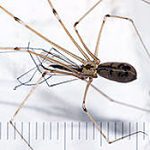The cellar spider or daddy longlegs (Pholcus phalangioides), also known as the skull spider due to its cephalothorax looking like a human skull, is a spider of the family Pholcidae. Females have a body length of about 9 mm; males are slightly smaller. Its legs are about 5 or 6 times the length of its body (reaching up to 7 cm of leg span in females). Its habit of living on the ceilings of rooms, caves, garages or cellars gives rise to one of its common names. In Australian homes, they are considered beneficial because it is sometimes believed they will kill and eat the venomous Redback spider.
It has the habit of shaking its web violently when disturbed as a defence mechanism against predators. They can easily catch and eat other spiders (even those much larger than itself, such as Tegenaria duellica), mosquitoes and other insects, and woodlice. When food is scarce, they will prey on their own kind.
Because they originally came from the tropics, these spiders do not appear to be influenced by seasonal changes and breed at any time of the year. The female holds the 20 to 30 eggs in her pedipalps. Spiderlings are transparent with short legs and change their skin about 5 or 6 times as they mature.
An urban legend states that these are the most venomous spiders in the world, but because their fangs are unable to penetrate human skin, they are harmless to humans. However, recent research has shown that pholcid venom has a relatively weak effect on insects. In the MythBusters episode “Daddy Long-Legs” it was shown that the spider’s fangs (0.25mm) could penetrate human skin (0.1mm) but that only a very mild burning feeling was felt for a few seconds.

